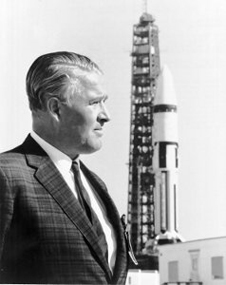January 29, 2010 Vol. 3, Issue 1
The years just prior to the founding of NASA were boon times for space visionaries.

Dr. Wernher von Braun in front of a Saturn IB Launch Vehicle at Kennedy Space Center in 1968. Photo Credit: NASA
“Man Will Conquer Space Soon!” proclaimed the Saturday, March 22, 1952, edition of Collier’s magazine. This issue was the first of several issues over the next two years that would feature articles on space travel by future NASA eminence Wernher von Braun and artwork by Chelsey Bonestell.
Stemming from careful calculations he made in 1948, von Braun’s first article in the Colliers series, “Crossing the Last Frontier,” discussed the design and construction of a space station orbiting Earth. He conceived of a fleet of rocket ships piecing together the 250-foot-wide station shaped like a wheel, imagining what the occupants of the station would feel as it spun around the earth at 20 times the speed of sound, and even detailing the types equipment and work technicians on board would have.
In a later issue, von Braun outlined a human expedition to Mars: a two-year mission consisting of a fleet of 10 shuttles and 70 crewmembers. Fifty of the explorers would land on the Martian surface.
Though his focus quickly shifted away from a human mission to Mars in the years following the Colliers series, von Braun’s legacy as a visionary lives on. During Masters Forum 17, Carolyn Griner, former deputy director at Marshall Space Flight Center, recalled her experience working with the von Braun team during the development of the Saturn launch vehicles. “They were driven by this vision. They were driven by this goal. There was nothing that was going to stand in their way,” she said. “And you know what? That meant that I felt like nothing could stand in my way.”
Five years after von Braun’s series appeared in Collier’s, the Soviet Union launched Sputnik 1, kicking off the space race. The United States already had its own satellites and launch vehicles under development (including von Braun’s work at the Army Ballistic Missile Agency in Huntsville, Alabama), but the field was still open to new ideas about how best to propel humans into a new age of space travel.
Carolyn Griner talks about the leadership she looked up to during the Apollo era and her fifteen minutes with Wernher von Braun. Video Credit: NASA
Perhaps the most audacious vision of the time was Project Orion, a top-secret project funded by the Department of Defenses Advanced Research Projects Agency (ARPA, known today as DARPA). Project Orion was a concept for an interplanetary spaceship powered by nuclear explosions. It attracted top physicists and mathematicians from around the country, including Theodore B. Taylor and Freeman Dyson, whose son George Dyson wrote Project Orion: The True Story of the Atomic Spaceship in 2002.
Project Orion quickly lost out to chemical propulsion systems as the U.S. geared up to send humans into space quickly in order to keep pace with the Soviets. In addition to the difficulty of selling the idea of exploding hydrogen bombs to propel a spacecraft, growing awareness about nuclear fallout radiation and its associated public health hazards led to a dramatic shift in attitudes toward nuclear energy and safety. The 1963 Treaty Banning Nuclear Weapon Tests in the Atmosphere, in Outer Space and under Water (also known as the Limited Test Ban Treaty) effectively marked the end of Project Orion as a viable concept.





